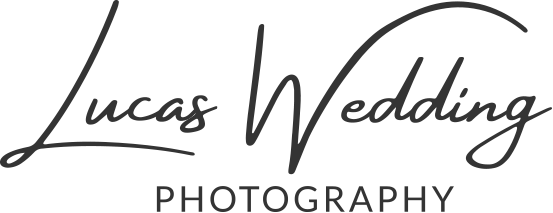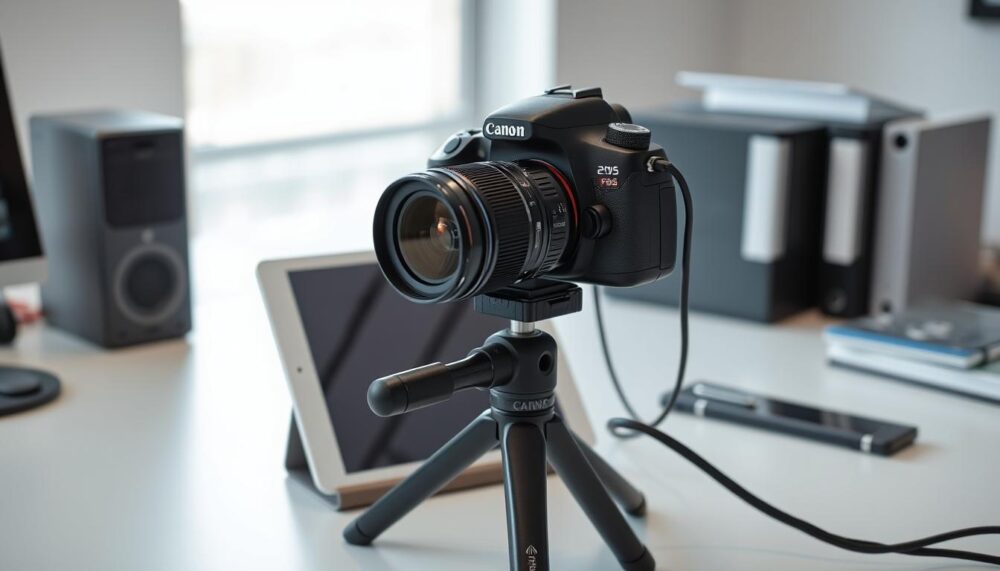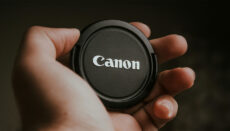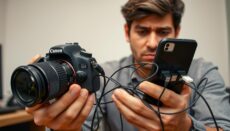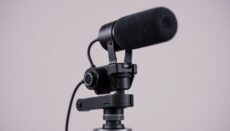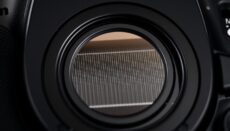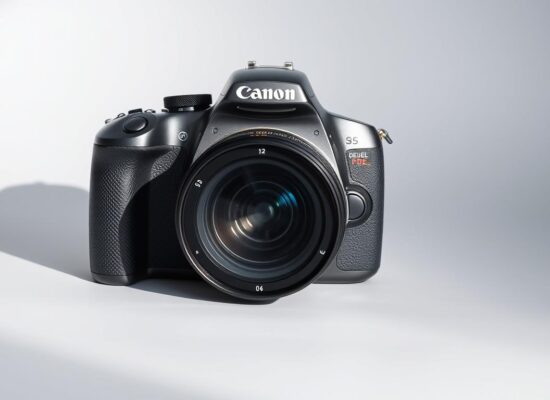Modern photography has evolved significantly, and pairing a Canon camera with an iPad opens up a world of creative possibilities. Whether you’re setting up a photo booth or capturing studio-quality images, this combination offers flexibility and convenience.
Gone are the days of relying solely on Windows-based systems. Today, user-friendly apps like Breeze Booth make the process seamless. With just a few steps, you can achieve professional results without the hassle.
One of the standout features is the compatibility with both USB-C and Lightning connections. This ensures real-time charging, so your devices stay powered throughout your session. Additionally, strobe flash compatibility enhances lighting, delivering crisp, high-quality images.
Another advantage is the dual storage option. Photos are saved directly to the SD card and the iPad Camera Roll, providing an extra layer of security. This setup is perfect for events, studios, or personal projects.
Key Takeaways
- Modern apps simplify the process of linking devices.
- USB-C and Lightning connections support real-time charging.
- Strobe flash compatibility ensures studio-quality results.
- Photos are stored on both the SD card and iPad Camera Roll.
- This setup is ideal for events, studios, and personal use.
Introduction
The journey from traditional setups to modern solutions has transformed photography workflows. In the past, Windows-based systems dominated the scene, requiring complex driver management and frequent updates. This often led to inefficiencies, especially in fast-paced environments like a photo booth.
Since the release of Wifibooth in 2015, the landscape shifted dramatically. Apple’s iOS devices, particularly the iPad, introduced a level of simplicity and reliability that was previously unheard of. This change marked the beginning of a new era in photography technology.
The 2020 iOS 14 update further enhanced this evolution by enabling direct USB connections. This meant that users could seamlessly link their cameras to their iPads without relying on Wi-Fi. Apps like Booth.Events took full advantage of this feature, offering a more stable and efficient solution compared to older, Wi-Fi-dependent systems.
Today, this setup supports a range of models, including the Canon M50, Sony A6300, and various Nikon cameras. One of the standout benefits is the ability to charge both the device and the camera simultaneously, ensuring uninterrupted operation during events. This combination of compatibility and convenience has made it a popular choice for professionals and enthusiasts alike.
What You Need to Connect Your Canon Camera to an iPad
Setting up your devices for seamless photography requires the right tools and compatibility checks. Ensuring you have the correct adapters, cables, and settings will make the process smooth and efficient.
Required Equipment
To begin, you’ll need a few essential items. A USB cable (Type-C or Micro-B) is crucial for linking your devices. Depending on your iPad model, you’ll also require either an Apple Lightning to USB 3 Camera Adapter or a Dockteck USB-C hub with power delivery. These adapters ensure a stable connection and real-time charging.
For those using older iPads with a lightning port, Apple’s official adapter is highly recommended. However, third-party alternatives can also work, provided they support data transfer and charging simultaneously. Don’t forget your iPad charging adapter to keep your device powered during use.
Compatibility Check
Before proceeding, verify that your Canon camera model is compatible. Most Canon EOS R/M series and DSLRs released after 2015 are supported, excluding the T6/1300D. Ensure your camera’s firmware is up to date for tethering functionality.
Next, check your iPad’s iOS version. It should be running iOS 15.2 or later. You can find this information in Settings > General > About. Additionally, format your memory card to exFAT if you plan to shoot 4K or larger files. This ensures smooth storage and transfer of high-resolution images.
By gathering the right equipment and confirming compatibility, you’re well on your way to a hassle-free setup.
Step-by-Step Guide: How to Connect Camera to iPad Canon
Streamlining your photography workflow starts with a few simple steps. By following this guide, you’ll ensure a smooth and efficient setup for your devices.
Step 1: Prepare Your Devices
Before making any connections, ensure both your iPad and camera are ready. Start by charging both devices to at least 80% battery. This minimises the risk of interruptions during use.
Next, check your settings. On your camera, set the exposure mode to ‘M’ and choose JPEG format (medium/fine). Disable RAW and HDR to prevent delays in transferring images. These adjustments optimise performance for continuous shooting.
Step 2: Connect via USB Cable
With your devices prepared, it’s time to establish a physical connection. Turn off your camera before attaching the cable. Use a USB-C or Micro-B cable, depending on your camera model.
Plug one end into your camera and the other into your iPad using the appropriate adapter. For iPads with a Lightning port, the Apple Lightning to USB 3 Camera Adapter is recommended. USB-C iPads can use a Dockteck hub with power delivery. This setup allows you to charge iPad and camera simultaneously.
Step 3: Configure Camera Settings
Once connected, grant camera access permissions on your iPad. Open your preferred app, such as Breeze Booth, and navigate to the settings menu. Rotate the live view if needed to match your shooting orientation.
Test the shutter response to ensure everything is working correctly. This step is crucial before starting any event or session. With these settings in place, you’re ready to capture stunning images effortlessly.
Using Different iPad Models
Understanding the differences between iPad models is essential for a smooth photography setup. Whether your device has a Lightning or USB-C port, knowing the right adapters and configurations ensures seamless compatibility with your camera.
Lightning Port iPads
Older iPad models, such as the Air series, feature a Lightning port. To connect your camera, you’ll need the MJYT2ZM/A adapter, which costs around £39. This adapter supports passthrough charging, allowing you to power both your iPad and camera simultaneously.
If you encounter the “USB Accessory Needs Power” alert, ensure your iPad is sufficiently charged or use a powered hub. Matching the orientation between your iPad and camera display is also crucial for a seamless experience.
USB-C Port iPads
Newer iPad Pro models (2018 onwards) come with a USB-C port, offering direct connectivity. Alternatively, multi-port hubs like the Anker 555 or Satechi Slim (£25-£60) provide additional functionality, such as daisy-chaining peripherals like microphones or LED panels.
These hubs ensure stable connections and power delivery, making them ideal for professional setups. Always verify compatibility with your specific iPad model to avoid any issues.
| Feature | Lightning Port iPads | USB-C Port iPads |
|---|---|---|
| Adapter Required | MJYT2ZM/A (£39) | Direct or Multi-port Hub (£25-£60) |
| Passthrough Charging | Yes | Yes |
| Recommended Hubs | N/A | Anker 555, Satechi Slim |
Transferring Photos from Canon Camera to iPad
Transferring photos from your Canon camera to an iPad is a straightforward process that enhances your workflow. Whether you’re using the native Photos app or third-party alternatives, understanding the options ensures smooth and efficient transfers.
Using the Photos App
The native Photos app is a convenient choice for importing images. When you connect your camera, the app automatically triggers the import process. This feature is ideal for quick transfers, especially during events or studio sessions.
However, the Photos app has limitations. Batch imports can be time-consuming, and it doesn’t support RAW file transfers. For high-resolution images, consider organising your albums by event dates or locations. This keeps your library tidy and easy to navigate.
Alternative Apps
For more advanced options, third-party apps like FileHub Plus and PhotoSync are excellent alternatives. FileHub Plus supports RAW transfers, making it a favourite among professionals. PhotoSync, on the other hand, offers seamless cloud backup integration during transfers.
If you encounter “Import Failed” errors, ensure your memory card is formatted correctly and your devices are fully charged. These apps provide flexibility and additional features, enhancing your photography experience.
- Automatic import triggers when connecting.
- Organise albums by event dates or locations.
- Third-party options: FileBrowser vs PhotoSync.
- Cloud backup integration during transfers.
- Resolve “Import Failed” errors with proper settings.
Troubleshooting Common Issues
Even with the best setups, occasional hiccups can disrupt your photography workflow. Whether it’s a connection issue or a photo transfer error, knowing how to resolve these problems ensures your session runs smoothly.
Resolving Connection Problems
If your devices aren’t linking properly, start by checking your camera settings. Ensure the exposure mode is set to ‘M’ and disable RAW or HDR formats. These adjustments can prevent delays in showing camera feeds on your iPad.
Full memory cards can also cause recognition delays. Clear space before starting your event to avoid interruptions. If you’re using a Sony a6000 series, note that compatibility may require additional steps, such as updating firmware.
For persistent issues, try these steps:
- Reset location permissions for camera access in your iPad settings.
- Update the Canon EOS Utility software to the latest version.
- Test with different USB cables, opting for certified ones over generic alternatives.
Fixing Photo Transfer Errors
When photos fail to transfer, the problem often lies in storage or settings. Ensure your iPad has enough space before importing large files. Formatting your memory card to exFAT can also help, especially for 4K or high-resolution images.
If you encounter the “Import Failed” error, check your camera settings and ensure both devices are fully charged. For stubborn connections, a factory reset might be necessary, though this should be a last resort.
By addressing these common issues, you can keep your photography workflow efficient and stress-free.
Optimising Your Photography Experience
Achieving professional-quality photos involves more than just the right equipment; it’s about mastering the details. Fine-tuning your settings and understanding how to use external lighting can elevate your results significantly. Whether you’re setting up a photo booth or working in a studio, these tips will help you get the most out of your setup.
Camera Settings for Best Results
Start by adjusting your camera’s settings to suit your environment. A shutter speed of 1/160s with an aperture of f/5.6 is ideal for capturing sharp, well-exposed images. Disable RAW and HDR formats to avoid delays in processing, especially during continuous shooting.
For portraits, consider using a diffuser attachment to soften the light. This technique reduces harsh shadows and creates a more flattering effect. Additionally, custom white balance using grey cards ensures accurate colour representation, even in challenging lighting conditions.
Using External Lighting
External lighting can transform your photography, especially in low-light scenarios. The Godox TT350C flash is a popular choice, offering compatibility with most Canon models. Syncing flash trigger systems via the hotshoe ensures precise timing, enhancing your strobe flash performance.
For multi-camera setups, ensure all devices are synchronised to avoid inconsistencies. Noise reduction techniques, such as increasing ISO gradually, can also improve image quality in dimly lit environments. By combining these strategies, you’ll achieve studio-quality results every time.
Maintaining Your Devices
Ensuring your photography gear remains in top condition is essential for consistent performance. Proper care of your device and camera not only extends their lifespan but also prevents disruptions during critical moments. Here’s how to keep your equipment in prime shape.
Keeping Your iPad Charged
To maintain optimal battery health, aim to keep your iPad’s charge between 20% and 80%. This practice helps preserve battery cycles and ensures your device is ready for extended use. For added convenience, consider portable power banks with PD 3.0 support. These provide fast charging and are ideal for outdoor shoots or events.
Camera Maintenance Tips
Regularly inspect your camera for dust or debris, especially on the sensor. Use a sensor cleaning kit to remove particles that can affect image quality. Conduct test shots to detect any dust spots and address them promptly.
For outdoor events, weatherproofing is crucial. Use protective covers to shield your camera from rain or extreme temperatures. Additionally, store your gear in a controlled environment with humidity levels between 30% and 50% to prevent moisture damage.
| Maintenance Task | Frequency |
|---|---|
| Sensor Cleaning | Every 3 months |
| Battery Health Check | Monthly |
| Weatherproofing | As needed |
By following these tips, you’ll ensure your photography equipment remains reliable and ready for any creative challenge.
Conclusion
Maximising your photography setup ensures smooth operations and professional results. Start by double-checking compatibility between your camera and iPad. Apps like Booth.Events simplify the process with automatic settings recall, saving time during events.
Future-proof your setup by considering USB4 or Thunderbolt adapters. These offer faster data transfer and charging capabilities, keeping your workflow efficient. For ongoing support, join Canon-iPad user communities to share tips and troubleshoot issues.
Before your first professional use, run through a final checklist. Verify connections, update firmware, and ensure your app settings are optimised. For more detailed guidance, refer to this step-by-step guide.
With these steps, your photo sessions will be seamless, allowing you to focus on capturing stunning images. Happy shooting!
FAQ
What equipment is needed to link a Canon camera to an iPad?
You’ll need a compatible USB cable (Lightning to USB or USB-C, depending on your iPad model) and a Canon camera with a USB port. Ensure both devices are charged and ready for use.
How do I check if my Canon camera is compatible with my iPad?
Verify your camera’s compatibility by checking its manual or the Canon website. Most modern Canon cameras support USB connections for photo transfer.
Can I use a memory card to transfer photos instead of a USB cable?
Yes, you can use a memory card reader compatible with your iPad’s port (Lightning or USB-C) to transfer photos without a direct connection.
Why isn’t my iPad recognising my Canon camera?
Ensure the USB cable is securely connected, the camera is powered on, and the iPad is unlocked. If issues persist, try restarting both devices or using a different cable.
Are there alternative apps for transferring photos besides the Photos app?
Yes, apps like Photo Booth or third-party options can facilitate photo transfers. These apps often offer additional features for managing and editing your images.
How do I optimise my Canon camera settings for better photo transfers?
Set your camera to ‘PTP’ (Picture Transfer Protocol) mode in the settings menu. This ensures seamless communication between your camera and iPad.
What should I do if my iPad runs out of battery during a photo transfer?
Keep your iPad charged using a power hub or external battery pack. This prevents interruptions during the transfer process.
Can I connect multiple Canon cameras to one iPad?
While you can connect multiple cameras sequentially, the iPad typically supports one USB connection at a time. Use a USB hub for multiple devices, but ensure compatibility.
How do I maintain my Canon camera for long-term use?
Regularly clean the lens and USB port, store it in a protective case, and avoid exposing it to extreme temperatures or moisture.
Does external lighting improve photo quality when using an iPad?
Yes, external lighting can enhance your photography experience, especially in low-light conditions. Consider using portable LED lights for better results.
